Recycled PET, or rPET, stands for recycled polyethylene terephthalate. It is a type of plastic that is commonly used in the production of various products, especially packaging materials like plastic bottles, containers, and polyester textiles. PET is known for its lightweight, durability, and versatility, which has contributed to its widespread use in the packaging industry.
Recycling PET involves collecting used plastic items made from PET, such as soda bottles and food containers, and processing them to create new PET material. The recycling process typically includes the following steps:
- Collection: Used PET plastic items are collected from consumers, recycling bins, or waste streams. These items are then sorted based on their color and resin type.
- Cleaning and Sorting: The collected PET items undergo thorough cleaning to remove labels, caps, and any contaminants like food residue or dirt. After cleaning, the plastic is sorted by color and resin type to ensure the quality of the recycled material.
- Shredding: The sorted PET items are shredded into small flakes or granules to increase their surface area and make them easier to process.
- Decontamination: The shredded PET flakes are subjected to a decontamination process to remove any remaining impurities, such as residual chemicals, colors, or foreign materials. This step is crucial to ensure that the recycled PET meets safety and quality standards.
- Repolymerization: The cleaned and decontaminated PET flakes are melted down and then reprocessed using a process called repolymerization. This involves breaking down the PET molecules into their original building blocks (monomers) and then reassembling them into new PET polymer chains.
- Extrusion and Pelletization: The reprocessed PET material is extruded into a specific shape, such as pellets or sheets, which can then be used as raw material for manufacturing new products.
- Manufacturing: Manufacturers can use the recycled PET pellets to produce a wide range of products, including new plastic bottles, packaging materials, clothing, carpeting, and more. These products contain a portion of recycled content, which reduces the need for virgin (newly produced) PET material and helps conserve resources.
Recycled PET offers several environmental benefits, such as reducing the demand for new petroleum-based plastics, conserving energy, and minimizing the accumulation of plastic waste in landfills and oceans. However, it’s important to note that the quality of recycled PET can vary based on the collection, sorting, and processing methods used, as well as the source of the original PET material.
回收聚對苯二甲酸乙二醇酯(Recycled PET),縮寫為rPET,是一種常用於製造各種產品的塑料,尤其是塑料瓶、容器和聚酯纖維等包裝材料。PET以其輕質、耐用性和多功能性而聞名,這些特性使其在包裝業得到廣泛應用。
PET的回收涉及收集使用過的PET製品,如蘇打水瓶和食品容器,並加工它們以創建新的PET材料。回收過程通常包括以下步驟:
- 收集:從消費者、回收箱或廢物流中收集使用過的PET塑料製品。然後按顏色和樹脂類型對這些製品進行分類。
- 清潔和分類:收集的PET製品經過徹底清潔,以去除標籤、蓋子和任何污染物,如食物殘渣或灰塵。在清潔後,根據顏色和樹脂類型對塑料進行分類,以確保回收材料的質量。
- 粉碎:將分類的PET製品切碎成小片或顆粒,以增加其表面積,使其更容易加工。
- 凈化:碎片的PET顆粒經過凈化過程,以去除任何剩餘的雜質,如殘留的化學物質、顏色或異物。這一步驟對確保回收PET符合安全和質量標準至關重要。
- 重聚合:經過清潔和凈化的PET顆粒被熔化,然後使用重聚合工藝重新加工。這涉及將PET分子分解為其原始構建塊(單體),然後重新組裝成新的PET聚合物鏈。
- 擠出和顆粒化:重新加工的PET材料被擠出成特定的形狀,如顆粒或片材,然後可以用作製造新產品的原材料。
- 製造:製造商可以使用回收的PET顆粒製造各種產品,包括新的塑料瓶、包裝材料、服裝、地毯等。這些產品含有一部分回收內容,從而減少了對新PET材料的需求,有助於節約資源。
回收PET具有幾個環境優勢,例如減少對新的石油基塑料的需求,節約能源,並減少了填埋場和海洋中塑料廢物的積累。然而,值得注意的是,回收PET的質量可能因所使用的收集、分類和加工方法以及原始PET材料的來源而異。
